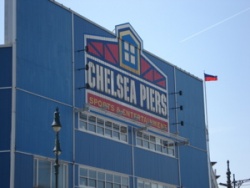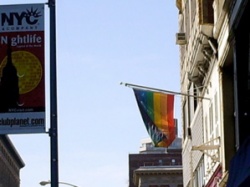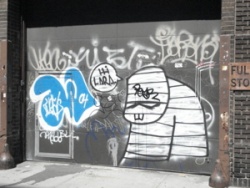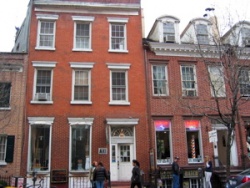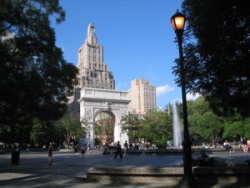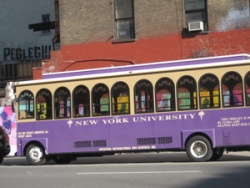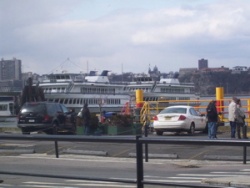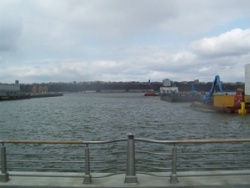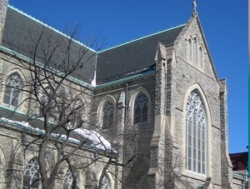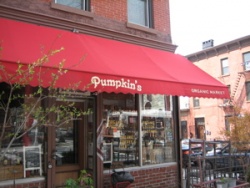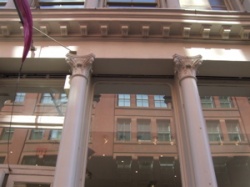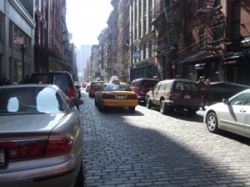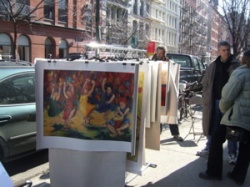Social Geography
From The Peopling of NYC
Social Geography is the study of the impact of physical locations on the society they are located in. Chelsea, Greenwich Village, Hell's Kitchen, Park Slope and SoHo have all been molded by specific sites, establishments and other geographic elements. By examining the impact each geographic characteristic has made, we hope to better understand the history of each neighborhood.
Chelsea
Chelsea's social makeup has always been tied to its piers. Dating back to 1907, three years before its opening in 1910, many famous ships, such as the Lusitania and Mauritania, were docked in Chelsea Piers. Though it was a welcoming stop to many European lines, the Piers were at the same time the first stop for many immigrants, specifically the Italian, Irish and Spanish. Once a ship had docked, its immigrant passengers were transferred to a ferry to be transported to Ellis Island or Freedom. By 1933, the Great Depression had hit, and Chelsea's use for transatlantic trade diminished. The Chelsea Piers had gone from "The most remarkable urban design achievement of their day," according to The New York Times, to "Today the Chelsea Piers are shabby pathetic reminders of a glorious past," words said at an attempt to replace Chelsea Piers with a highway running down the Hudson coast. However, the project failed, and in May 1992 was leased by The Chelsea Piers Management, Inc., which proposed to turn it into a sports and entertainment complex. Three years later, the Chelsea Piers started opening its stages once again.
The reborn Chelsea Piers as a fun place to be reflects the community's new attitude and feeling. As the gay community began to transform Chelsea, immigrants unable to afford the high rent moved out, and an influx of college educated whites took their place. Chelsea is now a relaxed and calmed place to live, open to people of diverse ethnicity. Just as Chelsea became a more luxurious and wealthy neighborhood with the aid of the gay community, it is now a central shopping and cultural location. Based on census and landmark data, Chelsea is not a family neighborhood. With its few parks and schools, Chelsea attracts many childless couples, both straight and gay.
Greenwich Village
When downtown business began to overrun residential streets in the 1820s and '30s, the middle and upper class fled north to the relatively sparsely settled Greenwich Village area. The significance of this development is that it created an exclusive residential housing market for the middle and upper classes. This is the first instance in a city of a modern lifestyle that separates work and residence -- the “commuter” was born. The commuter who could afford to travel to work, a luxury immigrants did not have. This housing and its socioeconomic implications essentially created a new spatial order in the city as well as a new social order.
Hell's Kitchen
Hell's Kitchen's docks greatly influenced its social makeup. First, the docks were the primary port for immigrants who upon first coming off the ship seek residence nearby. Second, the only kind of labor the majority of these uneducated, unskilled workers could supply was demanded at the same docks, and to remain within walking distance in an age of little mass transportation, these low-income immigrants remained close to the docks. As newer, more diverse immigrants began to replace those who had moved out, tensions began to flare, and gangs were formed. Essentially, the docks made Hell's Kitchen prime real estate to the low income unskilled laborers who were typically making their way to America.
Hell's Kitchen was also influenced by its proximity to Broadway, and therefore an abundance of theaters. The theaters attracted many actors to the neighborhood, to the point that Hell's Kitchen now has a reputation for being populated with performers, actors in particular. This accelerated the gentrification of Hell's Kitchen, as it led to the building of the Manhattan Plaza apartment complex, built especially for performers. The influx of actors was also one of the many factors that contributed to the growing gentrification of Hell's Kitchen.
Park Slope
Just by walking the streets of Park Slope, one is able to learn much about the neighborhood. By observing its churches, synagogues, schools and day cares, bars, restaurants, realty stores, and specialty stores, many conclusions about its residents can be reached. The churches, synagogues and restaurants show the diversity of the area, while the overwhelming number of schools and day cares display that Park Slope is not only known for its diversity but also as a great place to raise a family. The bars are there to serve the middle aged people and the numerous real estate stores provide evidence that a wealthy upper class has settled in the neighborhood. All of these buildings and institutions shape Park Slope and make it what it is today. To read more about the Social Geography of Park Slope, click here: Park Slope Social Geography.
SoHo
SoHo's geographical placement in Manhattan has directly influenced its evolution as a neighborhood. The quintessential SoHo appearance materialized in the decades after the Civil War, when industry sprung up in the area and drove the residents uptown. It’s birth as a manufacturing district is a consequence of its proximity to the immigrant-dense population of Greenwich Village and Little Italy. The symbiotic relationship between the immigrants, who found employment within walking distance of their homes, and their employers, who had almost unlimited access to cheap labor, nurtured SoHo’s existence in the growing city. The cheap labor also allowed the business owners to invest in beautifully ornate cast iron facades for which SoHo is famous. The cheap labor the immigrants provided allowed for ornate designs on the cast iron buildings creating beautiful facades. This new style of construction was cheaper and more aesthetically pleasing as it allowed for large windows. The wide-open interiors of the buildings were also ideal for industrial work.
Later, the factories closed and the large empty buildings were ideal for artists' lofts. The shells left by industry were given new life by a population attracted to SoHo because it was able to find treasure in another’s trash. Rent was affordable and many artists moved in. In 1968, seeing the enormous potential in what was emerging as a Mecca for art in America, Paula Cooper opened the first art gallery in SoHo. The prime location of the gallery gave it ample resources from which to gather samples of art to exhibit. This was truly a sign of things to come, demarcating a decline in artist influence in the area and a rise in the power of the galleries. a warning sign for artists that gentrification was occurring. Since then, most artists have moved out because rents have soared. Even galleries have been hurt by the circumstances they are responsible for. Within the last five years many galleries have moved elsewhere, in pursuit of artists, who are in turn in desperate search for affordable housing. Thus, SoHo’s geographical proximity to cheap labor ultimately shaped its character centuries later.
